A backstage pass
A bit of an odd gallery this month: I thought it might be fun to have a look at the parts of theatre which are not all that visible to audiences, including a few of the lethal things theatrical performers had to put up with not so long ago. So let's start our investigation with possibly the most lethal bit of (once) commonly used theatrical equipment:
-
Star trap from the Drury Lane Theatre.
Star traps were a type of trap door where a sort of see-saw was used to launch a person up from below at high speed – allowing them to do some acrobatic pose in mid air – after which they would come back down to stage level and land on the star trap after the nasty pointy spikes had fallen back into place (hopefully). And if the points hadn't fallen back in place... Well, there's a reason that they're banned now. Bram Stoker knew their dangers well:
| “ | ... it's no joke being driven up through the trap as if you was shot out of a gun. The points of the star had to be kept free, and the hinges at their bases must be well oiled, or else there can be a disaster at any time. Moreover, 'tis the duty of someone appointed for the purpose to see that all is clear upon the stage. I remember hearing that once at New York, many years ago now, a harlequin was killed by a 'grip' – as the Yankees call a carpenter – what outsiders here call a scene-shifter – walking over the trap just as the stroke had been given to let go the counter-weights. It wasn't much satisfaction to the widow to know that the 'grip' was killed too. | ” |
-
Backstage at the Vienna State Opera
This is a good example of the setup of a large modern (or, at least, modernised) theatre. To the the right, one can see the safety curtain partially blocking the view out. While often given a cloth-like look on the audience side, when viewed from the on-stage (where the audience can't see) many of them are clearly big reinforced metal frames. Because of the systems of pulleys and counterweights, they come down quite smoothly, which further gives the impression they're just a normal curtain. Of course, not all of them are metal, some are made from highly fire-retardant fabric. And from the same lethal side of theatre that once brought you the star trap, there were once "safety" curtains made of asbestos. We don't have pictures of those, but we do have pictures of the sane ones:
In these views of iron safety curtains, the first shows one without the fabric covering that normally hides its true nature from the audience, while the second shows one with the fabric covering. Also shown is the handle that drops the safety curtain, or fire curtain in American parlance. The idea of the safety curtain is that, if there's a fire, it separates the backstage from the front of house, which helps cut off the fire's air supply and slow its spread. And what happened before we had these devices in place?
Covent Garden Theatre burned down completely in 1808. This image dates from around 1856. Why so much time between the two? Because this is a picture of it burning down... for the second time, in 1856. Note how the fire is spreading between stage and audience – exactly the scenario safety curtains are meant to prevent.
The safety curtain can be quickly raised and lowered thanks to a system of counterweights and pulleys that allow curtains, backdrops, and even pieces of set to be raised and lowered without substantial difficulty. Metal pipes, called battens, are hung from ropes. The curtains, lighter bits of set, lights, and the occasional special effect device (like a container to drop confetti) can all be hung from them. Further, by lowering them nearer the stage, the need for ladders is greatly diminished.
-
Some of the drapes and curtains that can be used in a theatre. The ones off to the side hide actors and set pieces waiting to go on from the audience, since not all the audience is in the middle of the theatre.
-
Battens more-or-less fully raised.
-
The ropes holding everything up. If you're backstage, do not touch these unless you know what you're doing.
Finally, we need to build a set. This is traditionally made with a series of flats – freestanding walls that can be painted and decorated – as well as platforms, steps which act like any other set of stairs except for being more mobile. The effect can be quite visually stunning if done well:
-
Flats still under construction
-
A set in the process of being struck (disassembled), showing some of the framework that goes into the platforms and stairs.
-
A stage weight holding up a brace for a bit of scenery. The backstage needs to be traversed carefully.
-
A set design for Giuseppe Verdi's Otello, mixing flats, platforms, and backdrop curtains. Note the "round" tower in the back (as well as other parts) are just painted and shaded to give the illusion of depth, while being a flat piece of wood cut to shape.
Of course, this is a sampler. Perhaps your performance is going to be on a giant rotating set, often divided into halves or thirds, so that any redecoration can be done while acting is going on in the part of the stage facing forwards. This trick is also often done by having a scene in front of a curtain, whether the main curtain of the theatre or a backdrop near the front of the stage. Perhaps it's a minimalist set, where the audience's imagination and actor's reactions are meant to sell the scene. Perhaps you're doing a megamusical and have turned the whole stage into a roller skating rink so your actors can pretend to be toy trains being played with by a child (yes, that's a thing). Theatre can be strange, weird, and endlessly creative, so there's only so much that can be explained in the format of a gallery.
-
And don't even get us started on lighting and sound!

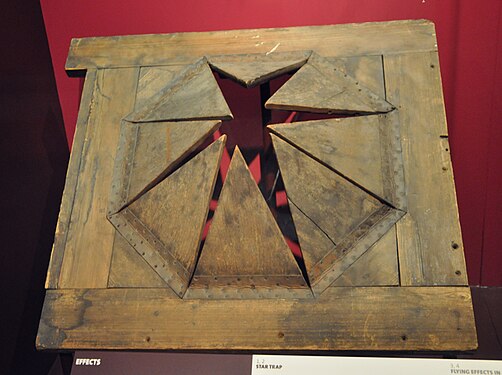





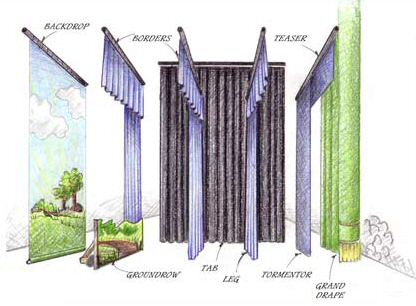
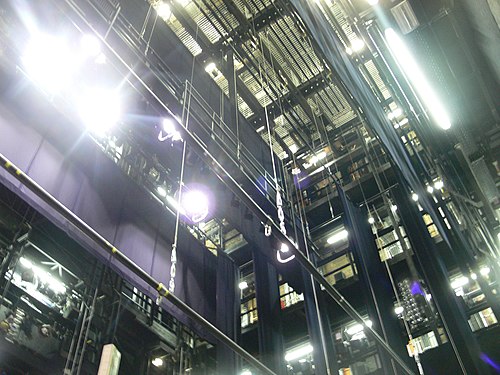

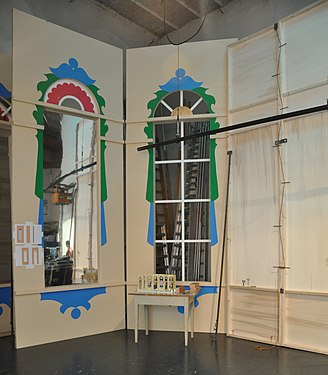
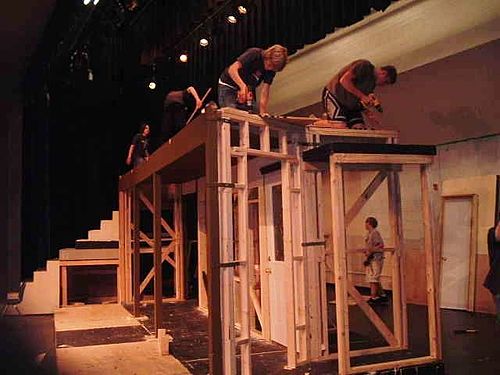
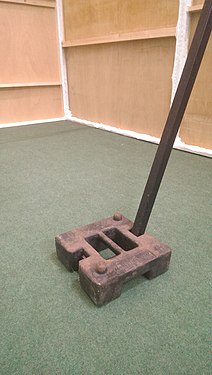



Discuss this story
...or https://collections.vam.ac.uk/item/O171646/star-trap-unknown/ Adam Cuerden ( talk)Has about 8% of all FPs 14:27, 1 August 2022 (UTC) reply